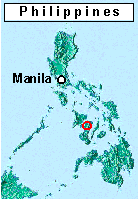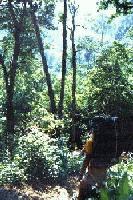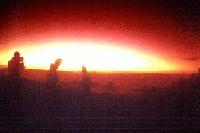Guides
  Canlaon
Climbing Guide Canlaon
Climbing Guide
The Environment
For many hundreds of years, man has passed through the
area we now call Mt. Kanla-on (Canlaon) National Park. He has gathered the products of
Nature which abound within its forests, has told stories of its creation, and
has developed a deep respect for its spirits and the wilderness.
Today, many of us are drawn to this mountain for many
of the same reasons--its legends, its spirits, and its primeval environment.
Evolving for over a million years, the wilderness of Mt. Kanla-on National
Park contains a delicate ecosystem containing plants and animals living in
harmony.
Left undisturbed, this natural balance will be maintained
and the natural cycles of life and evolution will continue forever. When
visiting this wilderness, we must be careful not to disturb this delicate
ecosystem.
And its Features
For a more enlightening park experience, an unhurried
quiet walk with a small group (ten to twelve at the most) lets the visitor
sense the unique environment. Travelling slowly through the dense
forest, one will discover each area somewhat different from the other; various
kinds of unique plantlife, from the enigmatic strangler fig
(a tree-killing vine that grows into a gigantic tree while strangling its host)
to delicate orchids and the ferns and epiphytes of the mossy forest.
Wildlife sounds abound beneath the triple-canopy forest
and if your group is quiet and observant, a number of these animals can be seen.
Mt. Kanla-on National Park is the home of many species of birds including the
endemic hornbill, colorful parakeets, and even migratory birds
from northern Asia. The huge but harmless monitor lizards scramble over
fallen logs and Draco the "flying" lizard might glide overhead. Although
there are several harmless species of snakes which are rarely encountered,
avoid handling any because the poisonous cobras make their home here too.
At the ridge top, panoramic scenes of sheer rock walls
and cliffs with the lush cover of the dwarf forest, clash with the Margaha
Valley's cogon grass and shrub-covered floor. Mornings come late and the
evenings early in the Valley. Pastel patches of greens, yellows, olives, ochres
and tans from agricultural lands below are suddenly cut by the deep blue sea
with cloud formations hugging the curve of the horizon.
The phenomenal clouds over Makawiwili Peak are
illustrative of the complex balance of Nature's forces Man has started to
respect.
Typical Four-Day Schedule
DAY 1
0700 Breakfast in Bacolod.
0800 Arrange for transportation to Mambucal Resort.
1000 At Mambucal, arrange for camp site or accomodations for the night.
1200 Have lunch and spend the rest of the day exploring or relaxing.
DAY 2
 0500 Breakfast.
0500 Breakfast.
0600 Start hike.
0630 Register at the Wasay Entrance to Kanla-on National Park.
0700 Hike up lower slopes through the dense rainforest.
1100 Stop for lunch at the first water source.
1200 Resume hike.
1500 Arrive at the Hardoy Sang Balo camp area. Set up camp here or continue
through the mossy forest to the next water source at Samoc Lagoon.
1800 Set up camp near Samoc Lagoon and prepare dinner.
DAY 3
0600 Breakfast.
0700 Break camp and start hike to summit.
0900 Reach PMS Lagoon. Rest and replenish water supplies.
0930 Climb ridge overlooking Margaha Valley.
1000 Continue past Makawiwili Peak around the extinct crater.
1200 Reach the eastern saddle just below Kanla-on Volcano. Set up camp and
have lunch
1300 Scramble up the lava and cinder-covered slope of the volcano. Spend the
afternoon exploring the summit and enjoying the panoramic views.
1700 Return to camp for dinner and preparation for the cold night.
DAY 4
 0500 Up early to watch the glorious sunrise.
0500 Up early to watch the glorious sunrise.
0600 Breakfast.
0700 Break camp and hike past the summit toward the western park entrance
Guintubdan.
1000 Reach Rancho Dos camp area. Rest and replenish water.
1200 Reach the Guintubdan Entrance Station. After lunch, meet pre-arranged
transportation or take public transportation back to Bacolod City.
1400 Return to hotel for a cool shower and a hot meal.
Special Considerations
- The best time to hike through Mt. Kanla-on National Park is during the dry
season between February and May. However, with proper equipment, the rainy
season can give the visitor an entirely different park experience with the
proliferation of "wet season" flora and fauna. (Editors note: It rains
year-round even during the "dry" season and the constant fog at the upper
elevations keeps everything wet so always be prepared for poor weather)
- The park contains more than 40-km of foot trails. Depending on your
physical condition, entry point, and time restraints, hikes lasting from
a few hours to several days can be planned.
- The Ara-al and Mapot trails provide pleasant one-day access to the summit.
While the Masulog trail offers the shortest route (8-km), it is a steady
uphill climb through the most severely damaged portions of the park. The
Wasay trail penetrates the most pristine wilderness of Mt. Kanla-on Park
affording the visitor two days of rain- and mossy forest environments.
- Be cautious near the crater's edge. Steep cliffs and loose volcanic rock
make this area particularly hazardous.
- Information and permits can be obtained at the Mt. Kanla-on National Park
Office, Bureau of Forest Development, Bacolod City.
-
View Trail Map (27k)
For More Information:
-
Department of Tourism
Region VI - Western Visayas
Capitol Ground, Bonifacio Drive, Iloilo City
Tel. (033) 337-5411 / 509-3550
E-mail: deptour6@iloilo.net
Other links on this site:
Take me back to Bundok's Guides Page |

